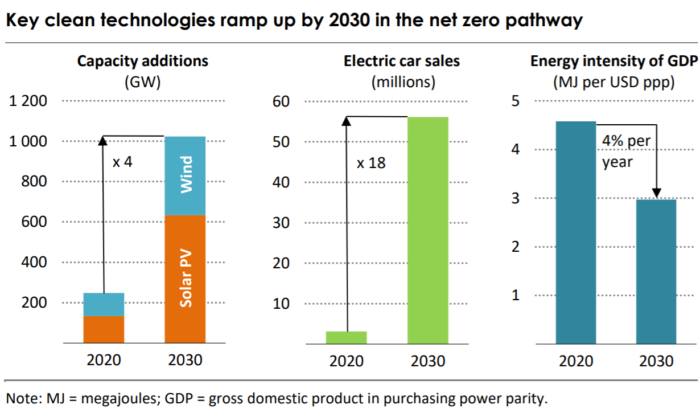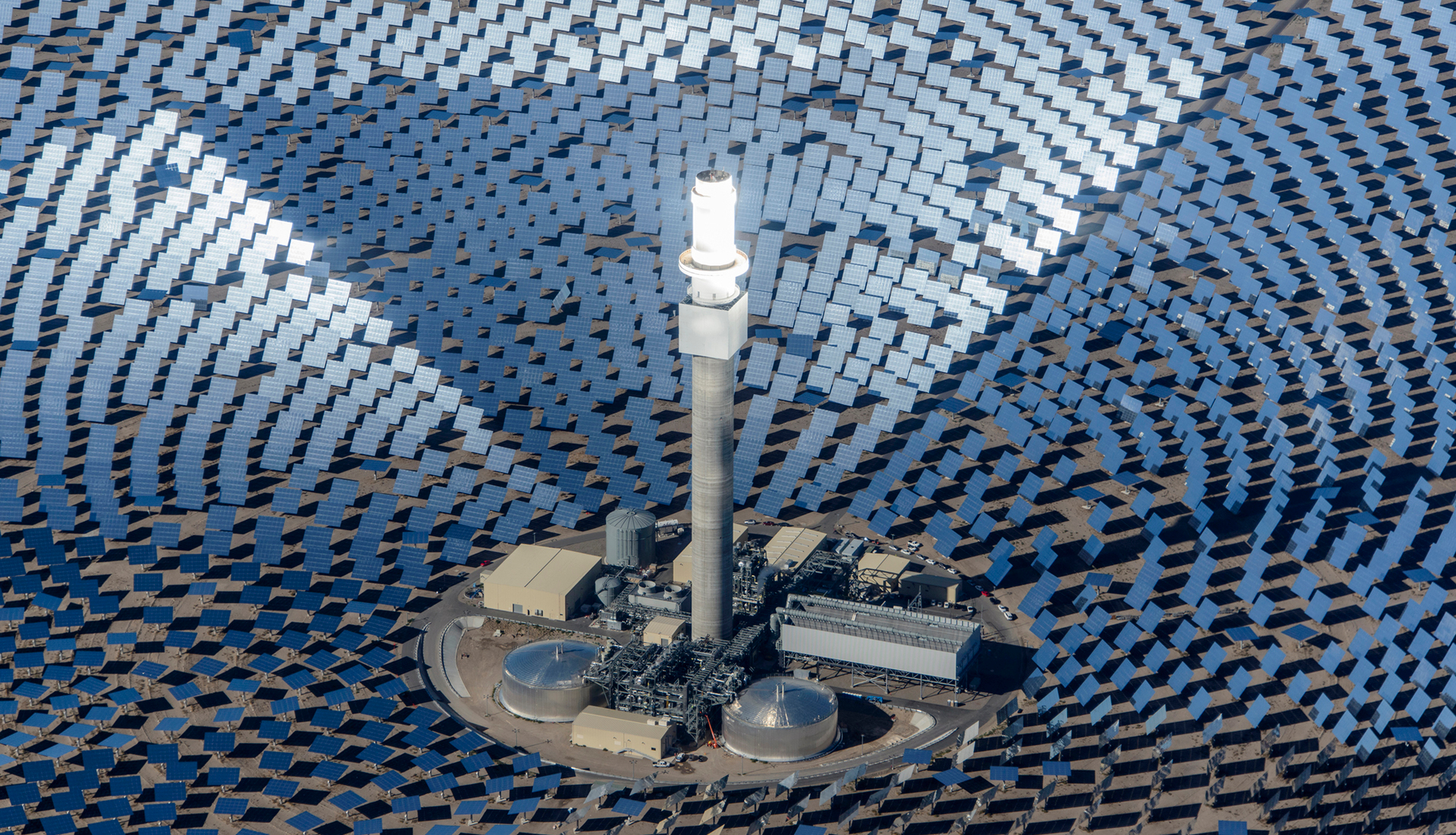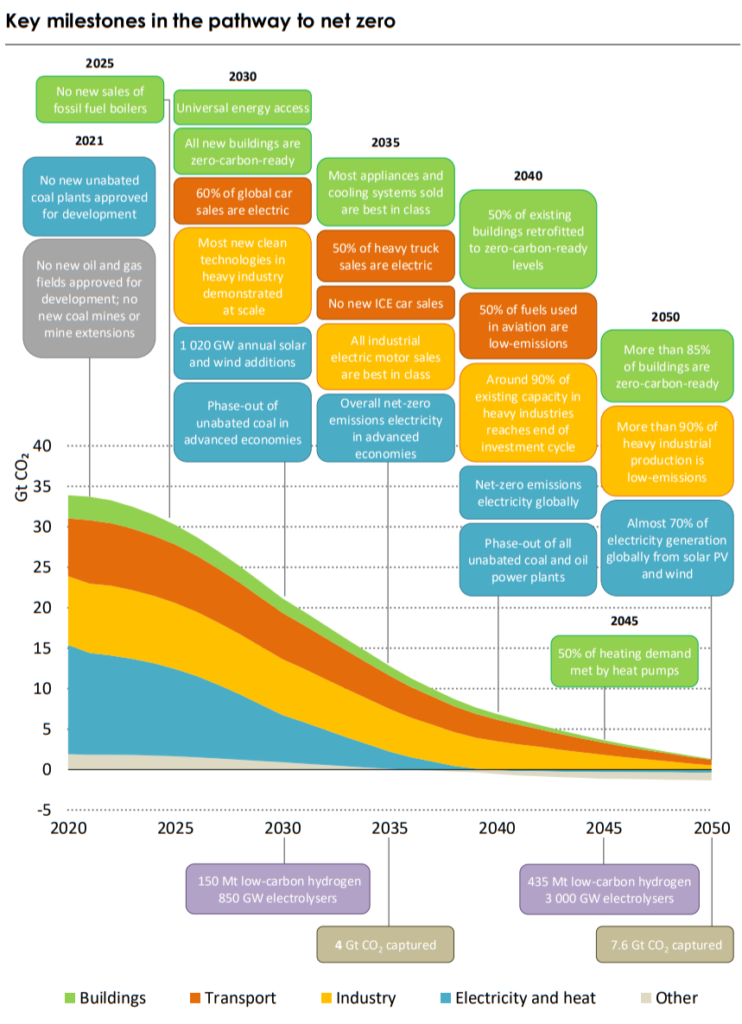We are approaching a decisive moment for international efforts to tackle the climate crisis.
Dr. Fatih Birol, Executive Director, International Energy Agency
A Detailed Global Plan to Stop Climate Warming
Our recent post discussing the role of energy consumption in driving climate warming referenced the rapid growth in renewable energy highlighted in the International Energy Agency (IEA) publication Global Energy Report 2021, issued in May 2021. While this is a tremendously encouraging development, we also noted that we were a long way from a definitive plan to reach global net zero GHG emissions soon enough to limit global temperature rise to the Paris Agreement goal of less than 2ºC. A new IEA report, Net Zero by 2050: a Roadmap for the Global Energy Sector, provides just such a global plan.
The rest of this post will take you on a quick tour of the IEA report, touching on the key issues and how they are addressed in the Roadmap. We will follow up with two more posts, the first taking a look at the results of the May 2021 meeting of the environment ministers of the G7 countries, and the second looking at related goings-on in and around the fossil fuel industry.
The IEA prepared the report at the request of Alok Sharma, the UK President of the 26th Conference of the Parties to the Paris Agreement (COP26), scheduled for November 2021 in Glasgow. As the report points out, the number of countries pledging to reach net zero emissions has grown rapidly in the last year and now covers about 70% of global CO2 emissions — a huge step in the right direction. However, most of these pledges are not supported by near-term policies and real commitments. Even if all the current pledges were somehow met, the result would be annual global emissions of about 22 billion tonnes of CO2 and a global average temperature increase in excess of 2ºC.
The IEA Net Zero 2050 report details a global roadmap for emissions reduction to net zero by 2050 that could well be a foundation for truly productive discussions and real progress at COP26. If we can reach net zero emissions by 2050, we will have a very good chance to stabilize the global average temperature increase at less than the 2ºC Paris Agreement goal, and a 50/50 chance of limiting climate warming to the aspirational goal of 1.5ºC.
The Global Energy Sector is the Key
Given that the energy sector is the source of about 75% of global greenhouse gas emissions, the IEA is uniquely positioned to create the plan to reach net zero emissions by 2050. As we’ve discussed previously, GHG discussions really boil down to the global energy system – how we generate energy and how we use it. While other sectors are important, notably agriculture and land use, necessary changes there are relatively straightforward and comparatively easy to implement. Re-engineering the energy sector is something else altogether.
Dr. Fatih Birol, IEA Executive Director, doesn’t mince words when describing the magnitude of the challenge, declaring that limiting climate warming to 1.5ºC:
“…requires nothing short of a total transformation of the energy systems that underpin our economies.”
The Net Zero 2050 report relies upon the IEA’s extensive energy sector modeling capabilities, bolstered by economics support from the International Monetary Fund. The report details over 400 specific milestones that must be reached along the pathway to net zero — key steps in the necessary evolution of technologies, infrastructure, investment and policy. It also assesses the cost of attaining the net zero 2050 objective, the impact on employment and the global economy, and the effects on society as a whole.
Roadmap Framework
The Net Zero 2050 roadmap was designed from the outset to maximize technical feasibility, cost effectiveness and social acceptability. Consequently, the pathway to 2050 reflects a number of realistic constraints.
The overriding goals of the IEA roadmap are enabling continued global economic growth and ensuring energy security, while giving the world a viable plan to limit climate warming.
The IEA’s predicted emissions reductions along the 30 year path to net zero assume no “emissions offsets” from other sources (e.g., growing new forests as carbon sinks to compensate for fossil fuel use.)
Technology solutions in the Roadmap do not plan on deploying Carbon Capture, Utilization and Storage (CCUS) and other “negative emissions” technologies until late in the 30 year pathway, recognizing that considerable development will be required before they are cost-effective and ready for deployment at scale.
Given that countries vary widely in their technological capabilities and economic capacity, the roadmap assumes the advanced economies reaching net zero earlier and more easily than developing economies and emerging markets, and thus will be in a position to assist others in reaching the global goal.
No Time to Lose
A key characteristic of the IEA roadmap is a very fast start, beginning in 2021. In the words of the authors, meeting the goal “requires immediate and massive deployment of all available clean and efficient energy technologies”— including electricity generation from renewables, electric vehicles and retrofitting buildings for energy efficiency — between now and 2030. By 2030, the roadmap forecasts a global economy 40% larger than today, but using 7% less energy because of increased efficiency.
Putting the challenge into perspective, the report describes the necessary growth in solar power generation as installing the equivalent of today’s largest solar farm every day. (Currently, the largest operational solar installation is the Bhadla Solar Park in India, with a capacity of 2.25 Gigawatts, covering an area of 14,000 acres.)
The chart below spotlights the high level milestones in the Roadmap to Net Zero 2050, and the cumulative impact on global emissions. The full report (pdf) is well worth reading, if only so we can compare the outcome of COP26 to the IEA recommendations! A more user-friendly interactive graphical representation of the timeline to 2050 is also available.
Milestones in the plan to reach Net Zero by 2050. Source: IEA
The Roaring 2020s
For the Roadmap to work, the 2020s must see an enormous expansion of clean energy. As we’ve covered in previous posts, this means electricity must become the dominant energy source going forward. Cost-effective solar and wind generation makes this possible, although ambitious. In the Roadmap, a “clean” electricity sector means phasing out fossil fuel power plants as they reach their design lifetime, while retrofitting emissions abatement technologies in the interim. Meanwhile, electricity enables emissions reduction in other sectors of the economy. The IEA forecasts electric vehicle sales growing from 5% of global car sales today to over 60% by 2030. As renewables take over the electricity sector, fossil fuel use declines rapidly.
Current sources of crude oil and coal will be more than sufficient for future needs, and this leads to the IEA’s more controversial headline recommendations:
- as of 2021, no new oil and gas fields approved for development,
- starting in 2021, no new coal mines or extensions to existing mines approved
- no new coal-fired power plants approved after 2021.
Considering that the IEA was created in the 1970s specifically to ensure the global supply of crude oil, these recommendations speak volumes to the urgency of dealing with the climate crisis. Nonetheless, the IEA Roadmap takes a realistic approach to phasing out existing technologies, recognizing that coal-fired power plants, for example, are currently in various stages of development in many developing countries, and financed based on an expected lifetime. The IEA strategy of not planning any more coal plants in the future, while mitigating emissions from the current fleet, balances the shift to renewable energy with economic realities.
The 2020s are crucial to reaching net zero by 2050. All the technology necessary to reach the near-term 2030 goals already exists, and there are proven government policies to drive their deployment instead of pursuing business as usual. This doesn’t minimize the challenge of implementing necessary standards and mandates to guide end users and incentivize industry investment. Among other things, we will need to implement limits and disincentives for some fuels and technologies to encourage change to cleaner solutions. Examples include unabated coal-fired power plants, vehicles powered by internal combustion engines, and gas-fired boilers.
The following chart shows the proposed ramp-up by 2030 of key technologies in the electricity generation and transportation sectors. Increased energy efficiency through the 2020s (reflected in the graph of Energy Intensity – the amount of energy used per unit of GDP) is also an early contributor to reduced emissions.

Large scale deployment of existing technologies enables significant emissions reductions by 2030. Source: IEA
Highlights on the IEA Road to Net Zero
Before we start, let’s see how high a mountain we need to climb.
Despite a sharp decline in global emissions in 2020, as the pandemic put a damper on energy use, 2021 will bounce back to near-2019 levels, with annual CO2 emissions of roughly 33 billion tonnes. That’s our starting point.
Okay then, let’s take a road trip.
2021:
- Global CO2 emissions are 33 billion tonnes (33 Gt)
- Governments no longer approve development of new oil and gas fields.
- No new coal mines or mine extensions are approved.
- No new unabated coal-fired power plants approved for construction.
- Unabated coal, oil and gas power plants generate more than 60% of total electricity
- Solar and wind generation account for 10% of total electricity
- 5% of cars are electric
2025:
- Global CO2 emissions are now 30.2 Gt
- Solar and wind generation is 20% of the total
- Last unabated coal-fired power plant completed
- In advanced economies all new buildings are zero-carbon ready (designed to be retrofit with clean energy sources when available)
- Fossil fuel-fired boilers no longer offered
2030:
- Global emissions reach 21.1 Gt annually
- Annual clean energy global investment reaches $4 trillion.
-
Low-carbon hydrogen begins production at scale using cheap electricity to drive electrolysers
- Global coal demand is down to 50% of 2020 levels
- 60% of new car sales are electric
- Advanced economies phase out unabated coal-fired power stations
2035:
- Global emissions drop to 12.8 Gt
- Cars driven by internal combustion engine no longer sold
- 50% of heavy truck sales are electric
- Advanced economies achieve overall net-zero electricity generation
- All unabated coal and oil power plant phased out in advanced economies
- Global fossil fuel use is 50% of 2020 levels
- Carbon capture utilization and storage technology is widely available
2040:
- Global emissions are 6.3 Gt
- Low emission fuels provide 50% of aviation requirements
- Global electricity generation reaches net zero emissions
-
Low-carbon hydrogen is now mainstream with increased electrolyser capacity
- Unabated coal and oil power plants phased out worldwide
- Oil demand is 50% of 2020 level
- Electricity is now the key energy source in all sectors, including transportation, industry and buildings
2045:
- Global emissions should reach 2.5 Gt
- The majority of road vehicles will run on electricity or fuel cells
- Biofuels or synthetic fuels will meet needs that can’t be electrified (aviation and shipping in particular)
- Widespread deployment of CCUS or hydrogen fuel in heavy industry
2050:
- Net zero global emissions
- Remaining emissions (about 7.6 Gt annually) counterbalanced by carbon capture. 2.4 Gt of the total captured from the atmosphere by a combination of bioenergy generation with CO2 capture and direct air capture
Is this for real?
To say that the IEA Roadmap is ambitious would be a massive understatement. If nothing else though, the report does two things very well. First and foremost, it shows that there is a solution — we could get to Net Zero in a few decades if we decided to do it. Second, it provides a number of useful milestones against which we can assess alternative proposals and future progress (or the lack thereof.)
I’m encouraged that we are even considering such an undertaking. Clearly, the spotlight is now on COP26 in November. Meanwhile, stay tuned for our two follow-up posts looking at the G7’s reaction and the current state of play in the fossil fuel industry.


